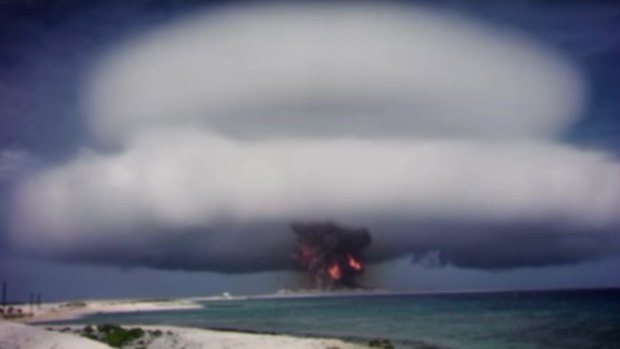This was published 7 years ago
Terrifying images revealed in declassified nuclear test videos uploaded to YouTube
By Ben Guarino
On Monday, the Lawrence Livermore National Laboratory, located in California, uploaded to YouTube more than 60 films taken during US nuclear weapons tests between 1945 and 1962. During this time, experimental nukes were dropped from bombers or propelled by rockets to altitudes as high as space.
Their offbeat names, such as Operation Hardtack 1, Operation Plumbbob and Operation Teapot, belied the massive destruction on display.
More than 200 nuclear test weapons would go off until 1963, when the Partial Test Ban Treaty required further testing to take place underground. In each instance, scientists trained multiple cameras on the explosion.
For decades afterward, thousands of these films languished in secure vaults - until Greg Spriggs, 65, a weapons physicist at Lawrence Livermore National Laboratory, decided to dust them off.

The test firing of a US nuclear weapon code-named Operation Hardtack was included in a new series of declassified footage recently released.
Some of the films had already degraded beyond the point of restoration. "You can smell vinegar when you open the cans, which is one of the byproducts of the decomposition process of these films," Spriggs said in a news release. "We know that these films are on the brink of decomposing to the point where they'll become useless."
He recruited expert archivists, including Zapruder film preservationist Jim Moye, to help digitise the footage.
"The data that we're collecting now must be preserved in a digital form because no matter how well you treat the films, no matter how well you preserve or store them, they will decompose," Spriggs said. "They're made out of organic material, and organic material decomposes. So this is it. We got to this project just in time to save the data."
Scientists are still able to wring new information from old detonations. Modern analytical techniques applied to digitised footage revealed inaccuracies in past estimates of fireball and shockwave size, which in many instances had been derived by hand.
"We were finding that some of these answers were off by 20, maybe 30, per cent," Spriggs said. "We've also discovered new things about these detonations that have never been seen before."
As the US no longer conducts nuclear tests, old data remains useful to weapon physicists who run computer simulations of attacks on the homeland or other nations. "We need to be able to validate our codes and trust that the answers that are being calculated are correct," he said.
Spriggs and the team of restorers have found about 6500 out of 10,000 reels from the era of above-ground nuclear tests, according to the news release. The researchers have scanned two-thirds of these films, and the Department of Energy has declassified just 750.
Why the government has only allowed the public to see the footage now was not an issue of secrecy - information about the operations had already been made public - but a matter of red tape.
"It's this big bureaucracy that just goes back and forth," Spriggs told Wired.
His process to declassify the footage took about 10 minutes per film to complete, Wired reported, as it required the physicist and another declassifier to review the reel and fill out a Department of Energy form. A third party at the Department of Energy then had to approve the request.
Spriggs said that he was motivated to declassify the footage as a way to visually remind the public of nuclear danger.
"I think that if we capture the history of this and show what the force of these weapons are and how much devastation they can wreak, then maybe people will be reluctant to use them," Spriggs said.
"We hope that we would never have to use a nuclear weapon ever again."
The Washington Post